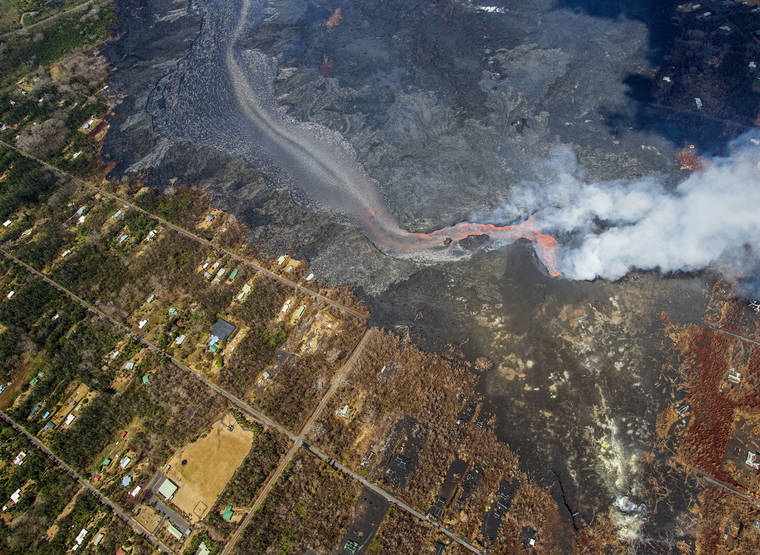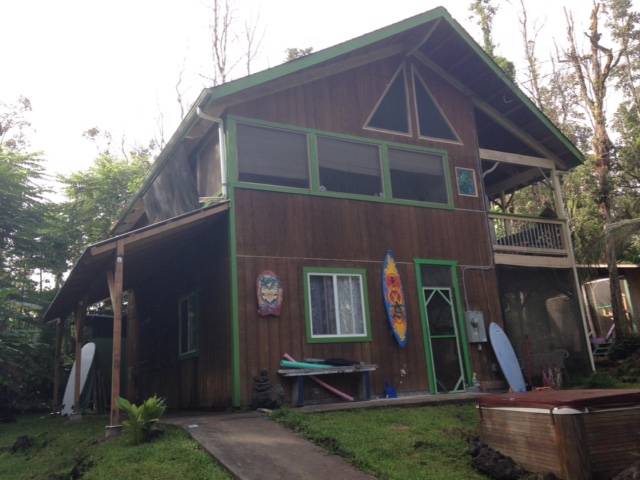Former Puna residents whose homes were destroyed by the 2018 Kilauea eruption can choose to sell their properties to the county through a nearly $80 million recovery program.
The Voluntary Housing Buyout Program is the central focus of an action plan submitted by the county to the U.S. Department of Housing and Urban Development in order to receive $83 million in Community Development Block Grant funding. Of that funding, $78 million would be used to buy out owners of property that was destroyed, isolated or damaged during the 2018 eruption.
The program, which is anticipated to begin in April 2021, will prioritize buying properties from households with low to moderate incomes, as well as properties that were owners’ primary residences, said Disaster Recovery Officer Douglas Le.
The program will first prioritize making buyout offers to documented primary residences, then secondary residences and finally undeveloped residential parcels. The action plan also stipulates that condos or other housing units that “share any common wall or area” will not be eligible for the program, nor will recreational vehicles or campers used as residences be compensated.
Le said the program will aim to buy out approximately 300 homes, although he added that is a benchmark based on property value assessments, not a hard target.
According to the action plan, 612 homes were destroyed during the eruption, 294 of which were primary residences.
Buyout prices will be determined by pre-eruption property assessments conducted in 2017, although the action plan specifies that no buyout price will go above $230,000, the median appraised market value of properties in the region during that time.
Because of this, Le said, no price distinction will be made based on the current state of a property — a property completely buried by lava will be bought out at the same price as an identical property only isolated by lava.
The county also will deduct the total of any insurance payouts for the property from the final buyout price, Le said.
Le also said that any structures on a property that is bought out will be demolished post-sale.
The program could be a lifeline for former residents struggling financially ever since the eruption.
Roger Meeker, president of the Kapoho Beach Community Association, said he suspects most property owners in the Kapoho area would be interested in the deal.
“Some people might be holding out for a better price, but if you’re listening to the scientists, it’s going to be a long time before there’s anything to go back to,” Meeker said.
Although the eruption ended almost two years ago, scientists determined that lower strata of the lava flows are still in a red-hot, liquid state and are dangerous to develop over.
Meeker said some property owners likely will take losses on the deal. Some Kapoho properties, he guessed, could have been worth nearly $1 million before the eruption, but he added that much of that value came from their beachfront location, which is no longer the case now that lava has completely filled Kapoho Bay.
Most owners, he said, will be better off taking what money they can from the deal.
Former Lanipuna Gardens resident Kieba Blacklidge said she speculates her property, a primary residence as well as a business, might be worth substantially more than $230,000 right now.
“Fissure 22 is right where my backyard was,” Blacklidge said, explaining that the slopes of the fissure could be a valuable source of cinder rock.
However, Blacklidge went on, the shelly pahoehoe lava around her property is too treacherous for her to even return. Without a plausible way to return to her property anytime soon, and needing more money to build a new home in Hawaiian Shores, Blacklidge said the program is looking more and more attractive.
“If it’s just $10,000, $12,000, I’ll probably decline,” Blacklidge said. “But if I got around $60,000, $70,000, that would be acceptable, I think.”
Leilani Estates resident Kris Burmeister, meanwhile, said he has no intention of selling his property, but supports the program nonetheless.
While his primary residence also was destroyed, Burmeister said he can still access his property, which includes a vacant lot neighboring his former home that was not entirely inundated.
“I can still walk right there, which makes me feel like I haven’t lost it at all,” Burmeister said. “I wouldn’t sell it for the world. I lucked out, but there’s a lot of people who didn’t.”
While Burmeister said he has heard some concerns from fellow Leilani residents that the county will turn the bought-back properties into a public trail system — an influx of tourists to the area “won’t fly down there,” he said — he generally supports a program that will keep the land from being redeveloped.
“Preserve it. Leave it alone. Let’s not make the same mistake twice,” Burmeister said. “Don’t bother redeveloping down there.
“People asked why the county allowed a subdivision to be built in Lava Zone 1 at all. If we redevelop down there, people will be asking the same thing the next time this happens.”
T
he action plan is available for public review at recovery.hawaiicounty.gov. The county is soliciting public comment on the plan, which can be submitted to kilauearecovery@hawaiicounty.gov until Aug. 18.
Email Michael Brestovansky at mbrestovansky@hawaiitribune-herald.com.


